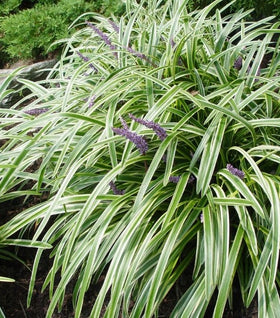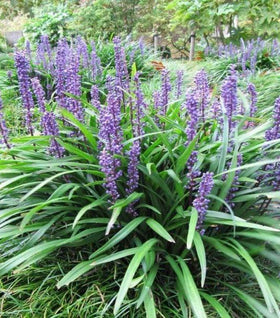Liriope Plants for Sale Online
Liriope, commonly called lilyturf or monkey grass, is an extremely popular and commonly used groundcover plant. Because they are some of the toughest and prettiest flowering perennial plats in existence and have so many uses, you’ll see the just about anywhere. Liriope is available in both clumping and spreading varieties.
The clumping varieties of lily turf are ideal for use as border edgers, lining a walkway, driveway, or landscape bed. The spreading varieties work well in large grouping or mass plantings to cover large spaces. Liriope is even known to do well under trees where they compete with the tree root system.
This beloved perennial groundcover also provides a nice grassy accent or centerpiece in mixed container gardens. In the summer, the hyacinth-like spikes in blue and lavender shades add to their overall appeal in the landscape. Liriope is also salt tolerant, making them perfect for planting along seawalls or near roadsides treated with salt during the winter months.
Using Liriope Plants in the Landscape
Use Liriope right along the edge of your path or planted bed. Big Blue Liriope and the Variegated Liriope do not spread by underground runners, so they stay in tidy clumps. Monkey grass can be used to define different areas of the garden. In areas of the landscape where you want a visual transition from one style of planting to another, plant liriope en masse to create this effect. They’ll provide an easy flow from one area of your landscape to another.
Silver Dragon Liriope plants can also be mass planted to create a no traffic lawn substitute. They naturalize quickly creating a no-maintenance green zone once established. All varieties are great for erosion control when used as a ground cover on slopes or other hard-to-landscape areas.
The variegated Liriope plants also contrast beautifully with evergreen shrubs such as Boxwood or Hollies. The grass-like foliage stands against the dark greens creating a brightening effect. No matter where you use it, Variegated Liriope will really brighten up any dull location. Liriope blooms reliably through the fall when other flowering perennials begin to fade.
Liriope looks great when planted in dry stream beds or areas of the yard with stone outcroppings. It can be used to soften the hard edges of the garden accents such as fountains or statuary.
Lilyturf plants can tolerate most conditions from full sun to dry shade. However, Liriope does prefer well-drained soil so that should be a consideration when deciding where to plant monkey grass. Although it is also known as an evergreen perennial, Liriope plants often look a bit worn when experiencing harsh winters. It is best to cut back Liriope plants in the late winter or early spring to give your garden a much tidier appearance; not to mention a much healthier plant.
For those gardeners with wooded backyards, all varieties of Liriope have also shown to be both deer resistant and rabbit resistant. So there is no need to worry about your investment getting chewed up by the local herds.
Using Liriope Plants in Containers
Liriope is easily grown in containers or patio planters and is often uses as a filler plant in the “Filler, Spiller, Thriller” planting design. In larger pots, add a liriope near the edge of the pot, surrounding taller flowers or “Thriller” Plants. Liriope can also be planted by itself in small to medium containers to add low maintenance color to your deck or patio.
Dividing Liriope Plants:
Liriope, like most perennial plants, can be divided every few years. Dividing liriope is not only beneficial to the gardener but is also beneficial to the plants. Over time as liriope ages, the center of an overcrowded clump or patch begins to die out as it cannot receive the necessary nutrients. If you see this happening, there is no reason to be concerned, it is simply the plant’s way of telling you that it needs to be divided.
To divide clumping liriope muscari, simply dig around the clump with a shovel and lift the clump. Lay the clump on a board or another solid surface and separate the clump using a sharp serrated knife. Each clump can typically be divided into two pieces or four. Give the remaining roots of each division a light pruning and replant as soon as possible.
This is a great cost-friendly way to increase the size of your liriope plantings. Eventually, you’ll get to the point where you will be able to offer neighbors and friends some liriope for their garden.
This process is the same with Liriope spicata varieties, such as Silver dragon Liriope. The only difference is that Liriope spicata forms mats, so it is easier to control the size of the division meaning they can be divided into smaller clumps as they’ll fill a larger area with fewer plants.
Water the newly planted clumps daily for 7 to 10 days to lessen the stress from dividing. After a week or so, follow the care instructions until the plants are established and healthy.
What’s the difference between 1 Gallon Liriope and Flats of 18?
We offer two size options for our liriope. You can purchase 1-Gallon Pots, which are great for those that require fewer plants or simply want a more mature plant from the start. Flats of 18 smaller plants are a great alternative if you are looking to mass plant. With this tray of 18 plants, you will find individual pots that are generally 2.5 inches long and wide by 3 inches deep. Many people find these easier to plant due to the shallow root ball. Although shallow, these plants are grown in soil and have well-established root systems.
Proper Spacing for Liriope Plants
Clumping Liriope plants:
The recommended spacing for the clumping variety is 12 to 24 inches apart; we find that planting them 18 inches apart is best. You will get a fuller look from the start and a much more appealing look with this spacing.
Another way to plant the clumping varieties is to do a double line, meaning two rows of plants. Each plant in the rows should be spaced 24 inches apart from the center of the plant and the second row should be 12 behind the first row with each liriope placed in between the plants in the first row. Every 3 plants will create a triangle. This planting method creates a visually appealing edge of liriope along walkways or around the perimeter of flower beds.
Spreading Liriope Plants:
Liriope spicata is planted slightly differently since they are generally used as true groundcovers and are meant to fill large areas. Liriope spicata fills in areas fasted when it is planted on 10-inch centers. In this planting method, plant a liriope every 10 inches in lines and space the lines 10 inches apart as well. Alternate the plants just like you would with the clumping varieties.
Depending on your budget or the quickness with which you want your space filled, this spacing can be adjusted up to 16 inches or down to 8.
You can use a plant calculator to help you decide how many plants you need for your project. Simply measure the length and width of your planting space. Multiply them together to get the square feet you’ll need to cover. By putting the square feet and your chosen spacing, you will be able to calculate how many plants you will need for your project.
Planting and Caring for Liriope plants
Once you’ve chosen the correct location for your Liripe, lay your plants out where you plan on placing them. This will help your work out any spacing issues before you commit to the layout.
After your spacing is correct, begin to dig the holes. If needed, you should amend your existing soil with locally sourced compost at this time. Place the plants in the hole so that the crown of the plant (top of the rootball) is at or slightly above the existing soil level. After placing the plant in the hole, hold the plant with one hand and keeping it straight, use your other hand to pull the soil back into the hole. As you backfill, it is important to compact the soil as you go to remove voids and air pockets.
At this time, give your plants a good, deep watering. Apply a one-inch layer of mulch and continue to water your Liriope every one to two days for the next few weeks. Frequent watering will encourage the plants to establish a good root system.



